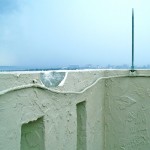The History of Lightning Protection Equipment
The history of lightning protection dates to the 1700’s, but there have been few advancements to the technology. The Preventor 2005 offered the first major innovation in the lightning protection industry since it started in the 1700’s. In fact, even today, common products being offered are frequently merely small traditional lightning rods connected with a maze of exposed wires – technology that dates from the 1800’s.
- 1749 – The Franklin Rod. The discovery of how electrical current travels brings to mind an image of Benjamin Franklin standing in a thunderstorm holding one end of a kite and waiting for lightning to strike. For his “experiment of procuring lightning from the clouds by a pointed rod,” Franklin was made an official member of the Royal Society in 1753.
For many years, all lightning protection consisted of a Franklin Rod designed to attract lightning and take the charge to ground. It had limited effectiveness and is today considered antiquated. Now this method is generally only considered satisfactory for church spires, tall industrial chimneys and towers in which the zones to be defended are contained within the cone.
- 1836 – The Faraday Cage System. The first update to the lightning rod was the Faraday cage. This is basically an enclosure formed by a mesh of conducting material on the roof of a building. Named after the English scientist Michael Faraday, who invented them in 1836, this method is not totally satisfactory because it leaves areas in the center of the roof between the conductors unprotected, unless they are defended by air terminals or roof conductors at higher levels.

In a Faraday System, the lightning protection is comprised of multiple lightning rods, not less than one foot high, fixed on all salient points on the roof. They must be bonded together with roof conductors and many down conductors to form a cage not greater than 50 feet x 150 feet and have air terminals at the intersections of center roof areas.
The building represented here is 150 ft. x 150 ft. x 100 ft. high. The Faraday method is costly to install, requires large amounts of equipment on a rooftop and multiple roof penetrations…but until the mid 1900’s, there was nothing better.
- 1953 – The Preventor. The Preventor is an ionizing air terminal which is dynamic in operation. J.B. Szillard began experimenting with ionizing lighting conductors in France, and in 1931, Gustav Capart patented such a device. In 1953, Gustav’s son Alphonse improved on his father’s revolutionary device, and his invention resulted in what we know today as the Preventor.
The Preventor 2005 was subsequently perfected by the Heary Brothers of Springville, New York.
Preventors are dynamic in operation, whereas, the former methods are static. For example, when a storm cloud approaches a protected building, the electric ion field between the cloud and ground is increased. The ions constantly flowing from the unit, carry some of the ground ion charges towards the cloud, and this has the effect of temporarily lowering the intensity of the ion field between cloud and ground. It must be clearly understood that it cannot neutralize a cloud. It does no more than reduce the tension for the small time during which the cloud is passing overhead – but this temporary lowering of the tensions is sometimes sufficient to prevent a lightning discharge from triggering off. On the other hand, when this lowering of tension is inadequate to prevent triggering, a conductive ion streamer is provided to conduct the discharge safely to the earth / ground system.
Heary Brothers has been in business since 1895 and is the largest and oldest manufacturer of lightning protection equipment in the world. They not only manufacture the Preventor, but also guarantee its performance. The guarantee is backed by a ten million dollar product insurance policy.
* Preventor 2005 model.

